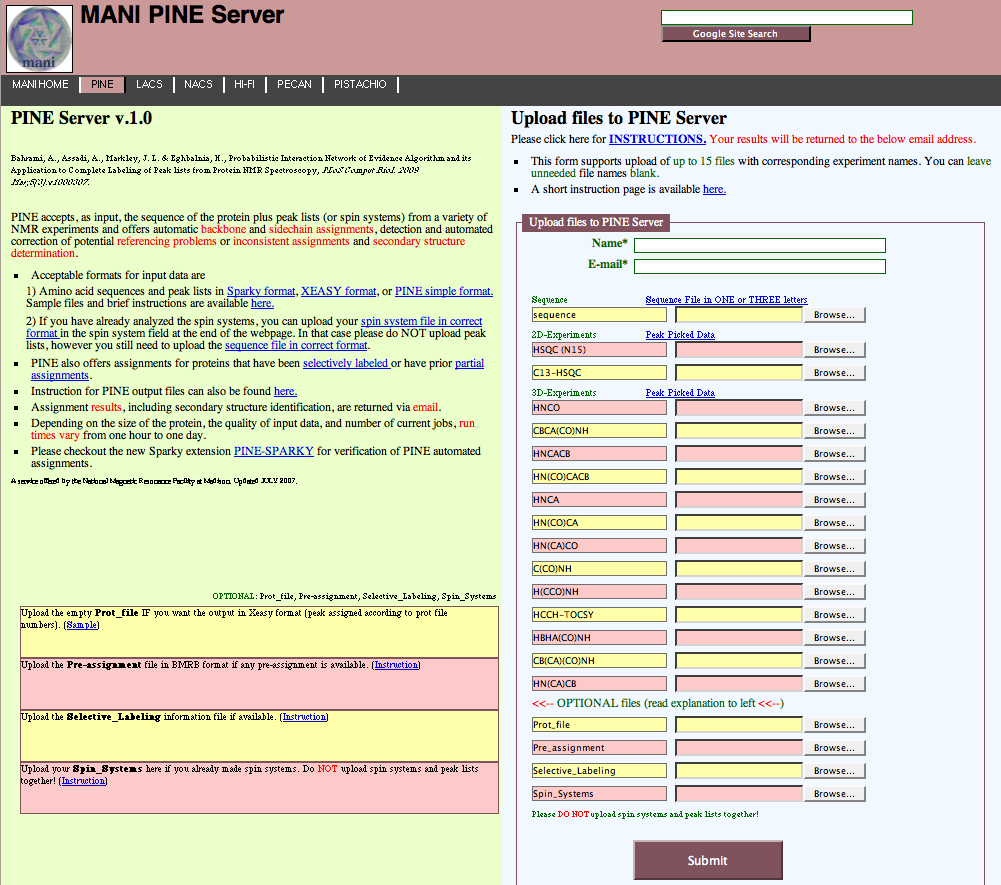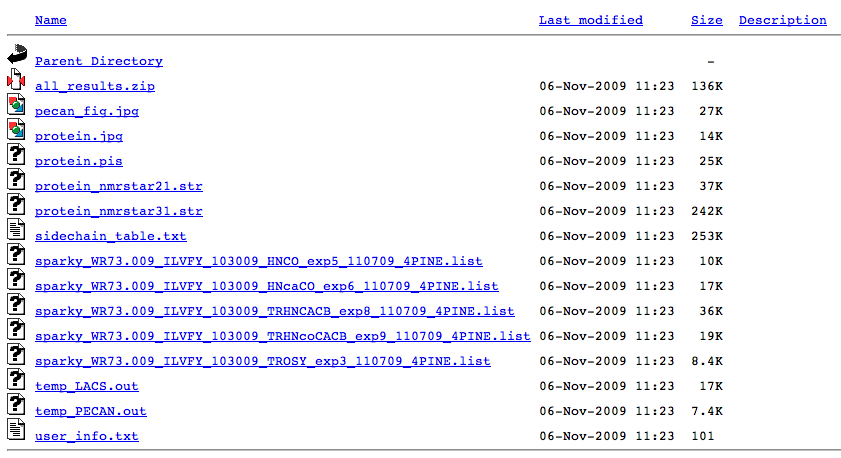Resonance Assignment/The PINE Server: Difference between revisions
No edit summary |
No edit summary |
||
| (2 intermediate revisions by 2 users not shown) | |||
| Line 1: | Line 1: | ||
== '''Introduction''' == | == '''Introduction''' == | ||
The PINE program (Probablistic Interaction Network of Evidence), recently developed by Arash Bahrami (NMRFAM, U. of Wisconsin), uses a novel aglorithm for the automated assignment of both backbone and side chain protein NMR resonances (Ref. 1). PINE is available from a freely accessible [http:// | The PINE program (Probablistic Interaction Network of Evidence), recently developed by Arash Bahrami (NMRFAM, U. of Wisconsin), uses a novel aglorithm for the automated assignment of both backbone and side chain protein NMR resonances (Ref. 1). PINE is available from a freely accessible [http://pine.nmrfam.wisc.edu/ web server]. It is reported to have > 90% accuracy for backbone resonances and > 80% for aliphatic side chain resonances. | ||
== '''Using the PINE Server''' == | == '''Using the PINE Server''' == | ||
| Line 25: | Line 25: | ||
==== Figure 1: The PINE Server ==== | ==== Figure 1: The PINE Server ==== | ||
[[Image:PINEserver.png]]<br> | [[Image:PINEserver.png]]<br> | ||
=== '''PINE Output''' === | === '''PINE Output''' === | ||
The user is e-mailed a list of PINE results files, as well as a zip file for download containing the entire output (Figure 2). | |||
The PINE output files include: | |||
*pecan_figure.jpg: shows the predicted secondary structure elements across the sequence | |||
*protein.jpg: a small figure showing the completeness of the assignment across the sequence | |||
*protein.pis: a text file showing the assignments and percent confidences over the entire sequence. This is particularly useful to study for any missing assignments. | |||
*the assignments in BMRB format | |||
*assigned peak lists in Sparky format | |||
==== Figure 2: PINE Results ==== | |||
[[Image:PINEresults.png]] | |||
== '''References''' == | == '''References''' == | ||
1. Bahrami, A., Assadi, A.H., Markley, J.L. and Eghbalnia, H.R. (2009) Probabilistic interaction network of evidence algorithm and its application to complete labeling of peak lists from protein NMR spectroscopy. ''PLoS Comput. Biol. 5'', e1000307. | 1. Bahrami, A., Assadi, A.H., Markley, J.L. and Eghbalnia, H.R. (2009) Probabilistic interaction network of evidence algorithm and its application to complete labeling of peak lists from protein NMR spectroscopy. ''PLoS Comput. Biol. 5'', e1000307. | ||
Latest revision as of 15:34, 27 April 2010
Introduction
The PINE program (Probablistic Interaction Network of Evidence), recently developed by Arash Bahrami (NMRFAM, U. of Wisconsin), uses a novel aglorithm for the automated assignment of both backbone and side chain protein NMR resonances (Ref. 1). PINE is available from a freely accessible web server. It is reported to have > 90% accuracy for backbone resonances and > 80% for aliphatic side chain resonances.
Using the PINE Server
Input Files
- amino acid sequence of the protein target either in single-letter or three-letter format.
- spectral peak lists. The program can accept peak lists in several formats including:
- SPARKY
- XEASY
- PINE
- additional information including:
- pre-assigned resonances
- amino acid selective labelling information
- grouped spins systems
The PINE Server
The PINE server is relatively simple to use (Figure 1). The user uploads the protein sequence, spectral peak lists and any additional information and simply submits to the server. There are extensive help links for the user on this main page. Note that for Sparky peak lists, the current version of the server (1.0) cannot tolerate the Notes column; so, remove this column prior to submission. The server returns the results by e-mail normally within a few minutes. If you have a problem, e-mail the Mani team.
Figure 1: The PINE Server
PINE Output
The user is e-mailed a list of PINE results files, as well as a zip file for download containing the entire output (Figure 2).
The PINE output files include:
- pecan_figure.jpg: shows the predicted secondary structure elements across the sequence
- protein.jpg: a small figure showing the completeness of the assignment across the sequence
- protein.pis: a text file showing the assignments and percent confidences over the entire sequence. This is particularly useful to study for any missing assignments.
- the assignments in BMRB format
- assigned peak lists in Sparky format
Figure 2: PINE Results
References
1. Bahrami, A., Assadi, A.H., Markley, J.L. and Eghbalnia, H.R. (2009) Probabilistic interaction network of evidence algorithm and its application to complete labeling of peak lists from protein NMR spectroscopy. PLoS Comput. Biol. 5, e1000307.

